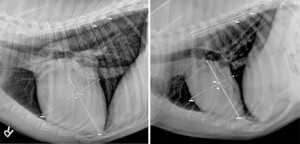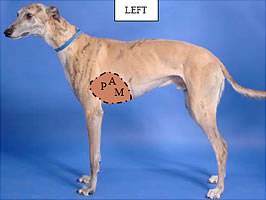Greyhounds, and all sighthounds, can be misdiagnosed with enlarged hearts and heart murmurs. Their hearts are larger than most breeds, and an EKG with an experienced vet consult is important for a correct diagnosis. Don’t let your hound be put on meds until you’ve consulted with a knowledgeable vet.
While you are here, here is a fantastic link about heartworm by Dr. Peter Dobias.
GREYHOUNDS…ALL HEART
Ohio State University Greyhound Health & Wellness Program
Greyhounds are gentle, sweet natured, docile, affectionate and dedicated dogs; they are all heart, aren’t they. Did you know that they actually have some differences in their cardiovascular system compared with other breeds?
Let’s start from their heart size; in veterinary medicine, there is a non-invasive method where cardiac size can be easily, rapidly, and objectively determined. The method is called vertebral heart size (VHS). With this method, measurements of the heart from lateral chest films or thoracic radiographs are used in a simple formula to determine the total VHS, based in the published reference range for VHS in dogs, which is 8.5 to 10.6.
In clinical practice, a VHS above the reference range on lateral thoracic radiogaphs supports cardiomegaly (enlarged heart), which is frequently associated with cardiac pathology, such as dilated or hypertrophic cardiomyopathy, pericardial effusion, pericardioperitoneal diaphragmatic hernia, tricuspid dysplasia, ventricular septal defect, or patent ductus arteriosus, among others.
Last year we generated reference ranges for VHS in Greyhounds, and they are 9.9 to 11.1. This range confirms that healthy Greyhounds have bigger hearts than dogs of other breeds.

Since the large heart in Greyhounds occurs in both, trained and untrained dogs, and it does not regress after cessation of training, previous studies suggested that it is due to genetic factors and not acquired through exercise and training.
HEART SOUNDS
The heart sounds normally heard in healthy dogs are S1 (associated with closure tensing of the AV valves at the onset of systole) and S2 (associated with closure of the aortic and pulmonic valves at the end of the systole). In addition to these normal sounds, other sounds may be present, such as heart murmurs.
Heart murmurs (abnormal heart sounds) are not usually part of the normal cardiac physiology, however, sometimes they are not clinically significant.
The heart murmurs are described by their timing during the cardiac cycle as systolic (when the heart is emptying or diastolic (when the heart is filling). The intensity of a murmur is graded on a 1 to 6 scale, and its point of maximal intensity is located and described as apex (apical or lower part of the heart) or base (basilar or top portion of the heart).

In 2006 we made the observation that a grade 1-2/ 6 left basilar systolic murmur was ausculted in many Greyhound blood donors, without evidence of abnormalities on echocardiograms, sometimes the murmur is not heard by auscultation of the heart, but the finding of a bruit (a heart sound heard over a vessel), which is heard using a stethoscope in the carotid artery in the neck, confirm the presence of the murmur.
In our study, we found that the b1ood flow velocity in the aortic valve in the Greyhounds with murmurs was significantly higher than in the Greyhounds without murmurs. In conclusion, although a soft murmur is common in adult Greyhounds, it does not appear to be associated with a congenital defect (e.; it is normal in sight hounds) or any CBC differences unique to this breed.
Due to these peculiarities in the Greyhound, we frequently receive referrals or consults of Greyhounds suspected of having heart disease, when indeed these findings are normal breed-related idiosyncrasies. This should be taken into account to avoid misdiagnosis and unnecessary medication.
RELATED AND RECENT PUBLISHED PAPERS AT GHWP
- Thromboelastographic tracings in retired racing Greyounds and in non-Greyhound dogs. Vilar P, Couto CG, Westendorf N, Iazbik C, Charske J, Marin L. J Vet Intern Med. 2008 Mar-Apr;22(2.):374-9.
- Postoperative bleeding in retired racing Greyhounds. Lara-Garcia A, Couto CG, Iazbik MC, Brooks MB J Vet Intern Med. 2008 May-Jun;22(3):525-33.
- Results of a web-based health survey of retired racing Greyhounds. Lord LK, Yaissle JE, Marin L, Couto CG. J Vet Intern Med. 2007 Nov-Dec;21(6):1243-50.
- Vertebral heart size in retired racing Greyhounds. Marin LM, Brown J, McBrien C, Baumwart R, Sammi VF, Couto CG. Vet Radiol Ultrasound, 2OO7JuI-Aug;48(4):332-4.
- Comparison of glomerular filtration rate between Greyhounds and non-Greyhound dogs. Drost WT, Couto CG, Fischetti AJ, Mattoon JS, Iazbik C. J Vet Intern Med. 2006 May-Jun;2O(3):544-6.
- Left basilar systolic murmur in retired racing Greyhounds. Fabrizio F, Baumwart R, Iazbik MC, Meurs KM, Couto CG. J Vet Intern Med. 2006 Jan-Feb;20(1):78-82.
Greyhounds & Heart Issues – Judy Paulson of Greyhounds Companions of NM
Many greyhound adopters across the country have been confronted with alarming news from their veterinarians concerning various heart abnormalities in their retired racers. Everything from “heart murmur” to “severely enlarged heart”, “congestive heart failure”, and “tachycardia or arrhythmia” has been offered as an explanation for various, vague symptoms and findings, with minimal evidence to support the diagnosis. And often, these conditions fail to present themselves upon evaluation by a veterinary cardiologist.
According to Care of the Racing Greyhound – A Guide for Trainers, Breeders and Veterinarians, “The greyhound has a large heart for its body size compared with other breeds. It has been shown that part of this is a genetic or inherited trait and part of it is the result of the exercise or work that a racing greyhound does.” However, Dr. Larry Tilley states that their hearts are really not necessarily any bigger, rather, there are some “false” changes because of the unique chest conformation of the greyhound that may give the appearance of a larger than normal heart.
As with any athlete, human or canine, the more exercise the body endures, the more conditioned it will become and all muscles, including the heart will exhibit some degree of hypertrophy (thickening or enlarging). According to Dr. Tilley, greyhounds have “totally different heart values”, particularly in relation to ultrasound testing, and cannot be compared to other breeds. An enlarged heart, as determined by ultrasound studies, does not always indicate disease of the heart. Certain physical conditions, such as obesity, natural aging changes or low thyroid can result in an enlarged heart, however the presence of actual cardiomyopathy (heart disease) such as congestive heart failure is not always the culprit.
Ultrasound studies of the heart (echocardiography), X-rays and electrocardiograms (ECGs) are the most reliable methods by which an accurate diagnosis can be made when there is a question of any heart abnormality. The inexperienced eye may erroneously diagnose “enlarged heart” in a greyhound if relying only on x-ray, due to the narrow chest and resulting elongated appearance of the greyhound heart. ECG results may register unusual and misleading large voltage readings due to the closeness of the heart to the chest wall, however, a veterinary cardiologist can discern these faux abnormalities and distinguish a physiologically normal heart from that of a diseased or abnormal heart.
“Irregular heartbeats” in greyhounds are not any more common than in most other breeds, and do not necessarily indicate a problem, as this may be present during a veterinary examination due to anxiety and nervousness in the greyhound. A diagnosis of arrhythmia or tachycardia may well be inaccurate unless confirmed by electrocardiography.
Heart murmurs in greyhounds appear to occur at a younger age than most breeds, however are likely to be genetic rather than indicative of pathology. As a general rule, though, greyhounds are no more likely to have heart murmurs than other large breed dogs. Only about 10% of all large breed dogs will present with a true heart murmur compared to approximately 85% of all small breed dogs. Murmurs can be detected in almost all breeds over the age of 10 years. If medication is being considered, ultrasound and/or ECG should be performed to determine the severity of the murmur . In Dr. Tilley’s opinion, medicating an asymptomatic dog for heart murmur is most likely of little or no benefit. Preventative antibiotics are not recommended in canines with heart murmurs (as in the case of pre-dental or pre-anesthesia) as they do not manifest infection the way humans with murmurs can.
In Dr. Tilley’s opinion, prescribing medication for an enlarged heart is not indicated unless the ultrasound is abnormal and the dog is symptomatic. The most common symptoms of congestive heart failure or other types of cardiomyopathy are chronic coughing accompanied by extreme lethargy.
The encouraging side of all the above is that the tests needed to rule out the presence of heart disease are surprisingly inexpensive and completely non-invasive. Anesthesia is not necessary and the expertise of a veterinary cardiologist is as close as the nearest computer terminal. Any x-ray, ultrasound or ECG can be transmitted via computer for evaluation by a veterinary cardiologist in an office such as Dr. Tilley’s.
If your greyhound (or other canine or feline) has been diagnosed with any type of heart abnormality, a thorough cardio evaluation would likely put your mind at ease. Ask your veterinarian about the possibility of a referral to a veterinary heart specialist – the peace of mind is well worth the time and reasonable fees and you may even avoid future expense in heart medication that is unnecessary. Some breeds are predisposed to heart disease, such as dobermans and boxers, but generally the greyhound’s most common heart diagnosis would more likely be “athletic heart”; indicative of a history of vigorous exercise rather than disease.